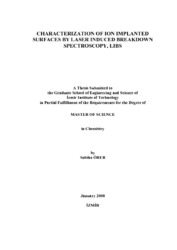Please use this identifier to cite or link to this item:
https://hdl.handle.net/11147/3994Full metadata record
| DC Field | Value | Language |
|---|---|---|
| dc.contributor.advisor | Yalçın, Şerife | - |
| dc.contributor.author | Örer, Sabiha | - |
| dc.date.accessioned | 2014-07-22T13:52:54Z | - |
| dc.date.available | 2014-07-22T13:52:54Z | - |
| dc.date.issued | 2008 | - |
| dc.identifier.uri | http://hdl.handle.net/11147/3994 | - |
| dc.description | Thesis (Master)--İzmir Institute of Technology, Chemistry, İzmir, 2008 | en_US |
| dc.description | Includes bibliographical references (leaves: 46-49) | en_US |
| dc.description | Text in English; Abstract: Turkish and English | en_US |
| dc.description | ix, 49 leaves | en_US |
| dc.description.abstract | Laser Induced Breakdown Spectroscopy, LIBS, is a versatile atomic emission spectrometric technique for the determination of the elemental composition of solids, liquids, gases and aerosols with the need for little or no sample preparation.In this study, an optical LIBS system from its conventional parts was designed, constructed and optimized for spectrochemical analysis of solid materials. Specifically, the 2-D elemental distribution of Ge ions on silicon oxide surfaces, prepared by the method of ion implantation, with differing atomic concentrations between 1016 - 1017 ions/cm2 have been investigated by LIBS. For this purpose a Nd: YAG laser operating at the second harmonic wavelength, 532 nm, was used to create a plasma on the material surfaces. Spatially and temporally resolved atomic emission from the luminous plasma was detected by an Echelle spectroctrograph and Intensified Charged Coupled Device (ICCD) detector combination. Spectral emission intensity from the LIBS measurements has been optimized with respect to time, crater size, ablation depth and laser energy. Atomic Force Microscopy (AFM) and Scanning Electron Microscopy (SEM) coupled with Energy Dispersive X-Ray Spectroscopy (EDX) have been utilized to obtain crater depth, morphology and elemental composition of the sample material, respectively. LIBS spectral data revealed the possibility of performing 2-D distribution analysis of Ge ions over the silicon oxide substrate at Ge ion concentrations lower than 0.5% (atomic). LIBS as a fast semi-quantitative analysis method with 50.m lateral and 800 nm depth resolutions has been evaluated. In this wok, elemental analysis of some metal surfaces, such as Al and Cu, was also performed by LIBS.Keywords: LIBS, surface analysis, Ge ion implantation, lateral resolution, | en_US |
| dc.language.iso | en | en_US |
| dc.publisher | 01. Izmir Institute of Technology | en_US |
| dc.rights | info:eu-repo/semantics/openAccess | en_US |
| dc.subject.lcc | QD96.L3 O669 2008 | en |
| dc.subject.lcsh | Laser spectroscopy | en |
| dc.subject.lcsh | Laser-induced breakdown spectroscopy | en |
| dc.subject.lcsh | Surfaces (Technology)--Analysis | en |
| dc.subject.lcsh | Ion implantation | en |
| dc.title | Characterization of Ion Implanted Surfaces by Laser Induced Breakdown Spectroscopy, Libs | en_US |
| dc.type | Master Thesis | en_US |
| dc.institutionauthor | Örer, Sabiha | - |
| dc.department | Thesis (Master)--İzmir Institute of Technology, Chemistry | en_US |
| dc.relation.publicationcategory | Tez | en_US |
| dc.identifier.wosquality | N/A | - |
| dc.identifier.scopusquality | N/A | - |
| item.openairecristype | http://purl.org/coar/resource_type/c_18cf | - |
| item.languageiso639-1 | en | - |
| item.openairetype | Master Thesis | - |
| item.grantfulltext | open | - |
| item.fulltext | With Fulltext | - |
| item.cerifentitytype | Publications | - |
| Appears in Collections: | Master Degree / Yüksek Lisans Tezleri | |
Files in This Item:
| File | Description | Size | Format | |
|---|---|---|---|---|
| T000739.pdf | MasterThesis | 2 MB | Adobe PDF |  View/Open |
CORE Recommender
Page view(s)
186
checked on Mar 31, 2025
Download(s)
128
checked on Mar 31, 2025
Google ScholarTM
Check
Items in GCRIS Repository are protected by copyright, with all rights reserved, unless otherwise indicated.